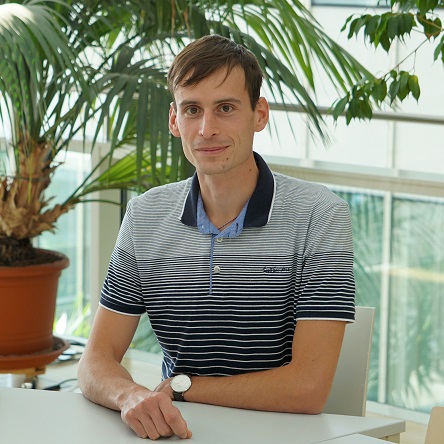As part of the ARCADES research network, RISC Software Ltd. supervises Ph.D. students working on a new generation of CAD programs.

Jan Legerský is one of three doctoral candidates in the training network program working at RISC Software Ltd. Both RISC Software Ltd. and the RISC institute actively taking part in the ARCADES Training Network. Alexander Leutgeb (Industrial Software Applications Unit) is a specialist in realistic and detailed simulations and a project manager for numerous outstanding long-term research and customer projects and currently oversees the junior scientists in the program. One of these projects is the Virtual Modeling Library (VML), a software library that enables new algorithms for accurate geometrical modeling of solids in real-time.
RISC: Where are you from and what is your (academic) background? What are you studying and why?
Legerský: I am from Czechia. I studied Theoretical Computer Science at the Faculty of Nuclear Sciences and Physical Engineering at the Czech Technical University in Prague (CTU). Although we studied physics during the first two years of my undergraduate program, mathematics was more fun due to its beauty and rigor. I also like to work with computers, conducting mathematical research. In this regard, the Research Institute for Symbolic Computing was an ideal choice to pursue my doctorate degree.
RISC: Tell us more about the project and ARCADES. What are the project’s main objectives and what have you been able to achieve so far?
Legerský: I am currently a junior scientist in the Marie Sklodowska-Curie Innovative Training Network ARCADES. My dissertation focuses on so-called graphs with flexible labeling – planar links made of rods connected with hinges and specially selected so the rods can move. Our most significant accomplishment is the combinatorial characterization of these types of graphs. We are currently developing methods to design lengths that guarantee mobility.
RISC: Alexander, how does RISC Software Ltd. benefit by attracting junior scientists and collaborating with them?
Leutgeb: Students spend four to five months working on concrete problems in the field of computational geometry with industrial applications. During this time period, they learn to design algorithms for theoretical methods and incorporate them into industry-relevant programming languages such as C++ or Python. RISC Software Ltd’s advantage is getting to learn more about the most recent researching findings in the field of computational geometry and incorporate these findings in research and industrial projects. It is also in RISC Software Ltd’s best interest, of course, to attract Ph.D. candidates as potential future employees.
RISC: Jan, what has your stay at RISC Software Ltd. been like and what have you experienced?
Legerský: During the past few months at RISC Ltd., I have had an opportunity to work in another field aside from my dissertation topic. I implemented a fast algorithm to calculate the Hausdorff distance between two triangular meshes. Roughly speaking, it is a metric that quantifies the geometric difference. I appreciate the fact that I was able to refresh my expertise in C++ as it could be very relevant for me in the future. It was also very interesting to program for the Virtual Modeling Library. It is one of the largest projects I have ever been a part of.








